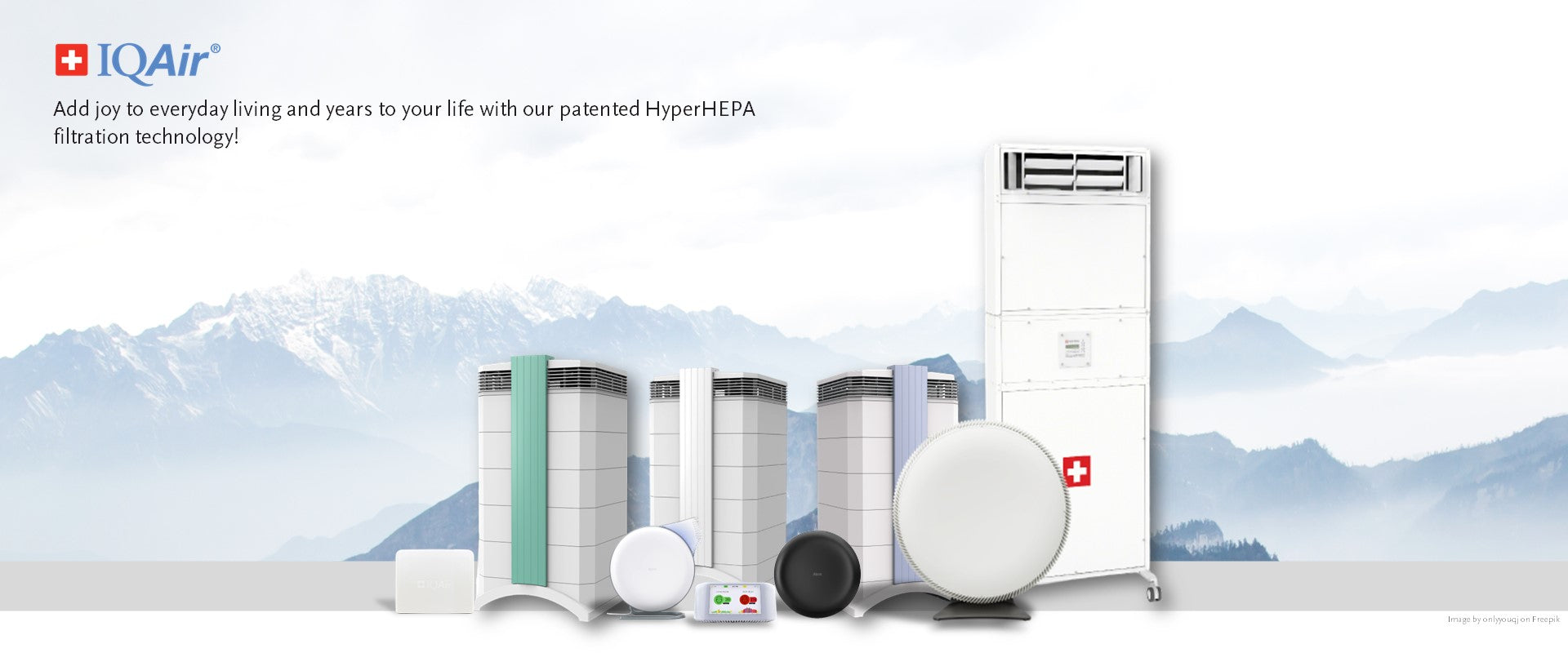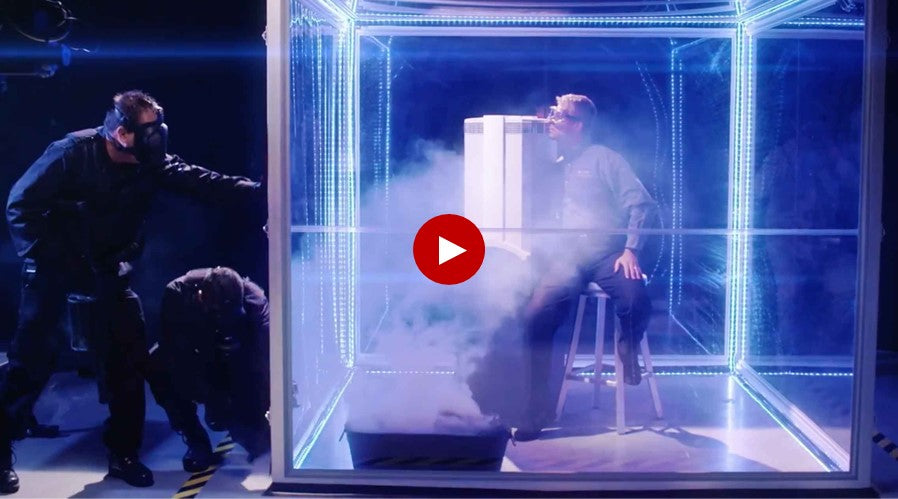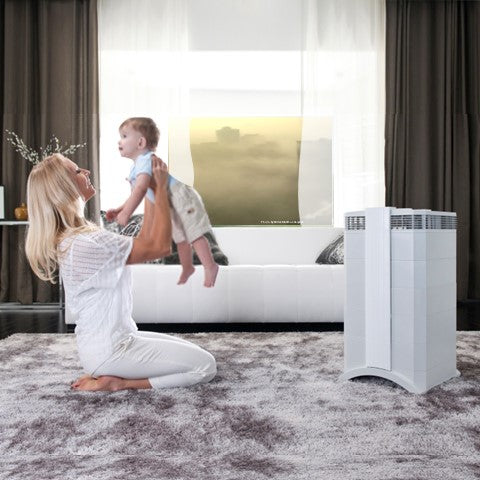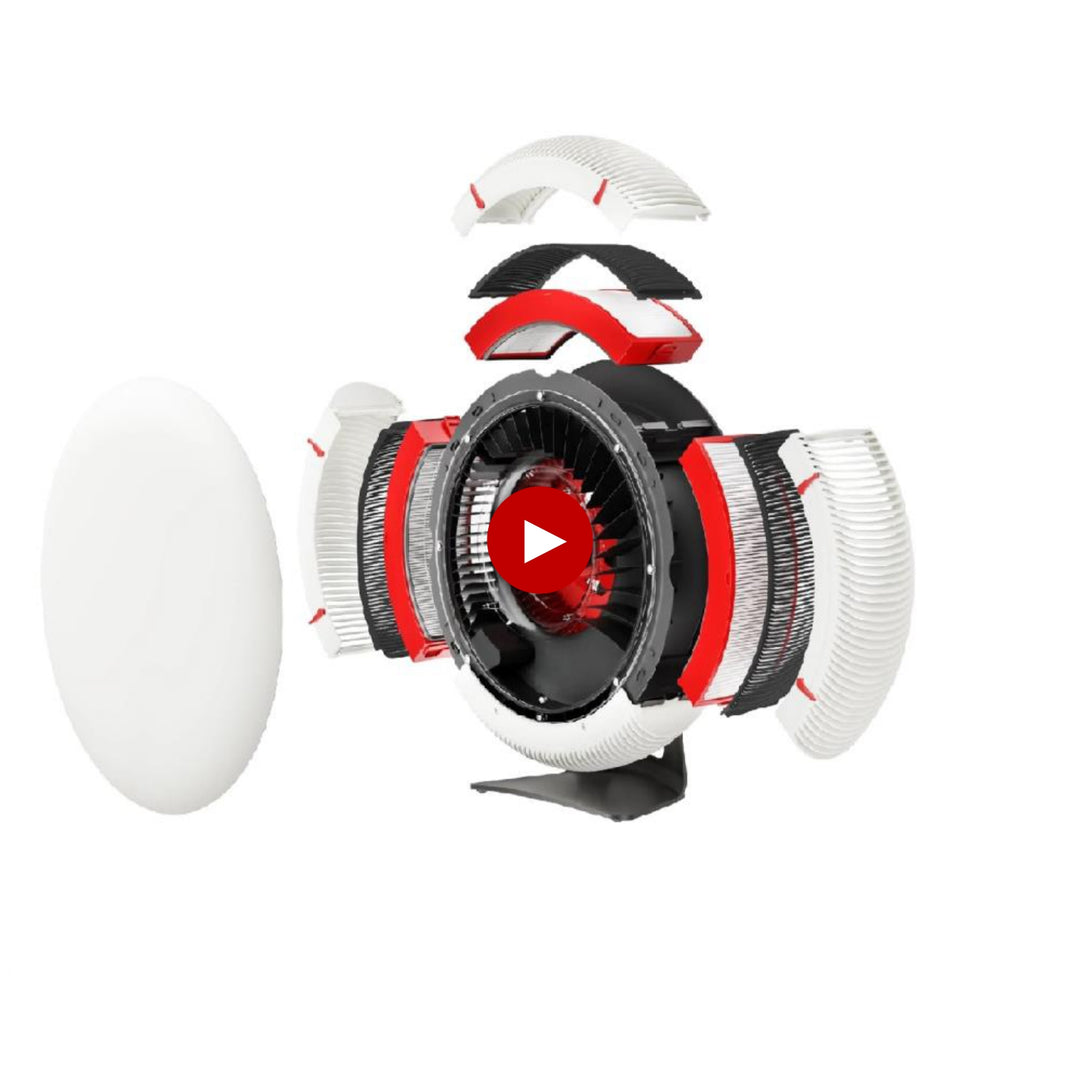Our Series
See the Change



IQAir HyperHEPA Technology Filters COVID-19, MRSA, and More
IQAir’s HyperHEPA technology has been tested and proven to filter biological contaminants, bacteria, and viruses in their airborne state. This includes aspergillosis, MRSA, and SARS-CoV-2, the virus that causes COVID-19, which is the major reason that HyperHEPA filtration was used by the Hong Kong Hospital Authority to help protect staff and patients during the SARS-CoV-1 epidemic and the SARS-CoV-2 pandemic.

HyperHEPA filtration
The IQAir HealthPro Series features HyperHEPA filtration technology for excellent airborne particle removal. IQAir’s HyperHEPA filtration is tested and certified by an independent third-party lab to filter 99.95% of harmful ultrafine pollution particles down to 0.003 microns in size. This is 100 times smaller than 0.3 microns.

Certified performance
IQAir individually tests each HealthPro Series at the factory to verify that your HyperHEPA filtration is meeting our exacting standards in reality, not just theory. We test total system efficiency – the actual air coming out of the outlet. If the system is not delivering 99.97% cleaner air or better, we don’t ship it. Period. The results of the tests are detailed in a hand-signed Certificate of Performance, which is shipped with every HealthPro system.
Residential Air Purification
Learn more about our selection of air purifiers that are perfect for your home, and discover how we can assist you in creating cleaner, breathable air in your living space.
Personal Air Purification
We offer air purification solutions for your car and other spaces, ensuring you have breathable air
wherever you are
Commercial Air Purification
Tailored solutions for large commercial spaces, factories, offices, and public areas create highly productive environments.
FAQs
Depending on the level of air cleaning desired, the IQAir system can be operated as frequently as needed. For general air cleaning purposes, the system should filter the room air volume at least twice every hour on the set fan speed in order to achieve a significant air quality improvement. If the intensity of the pollution source is high or a high degree of purification is needed, more air changes may become necessary. More air changes may be achieved by selecting a higher fan speed and/or by running the room air cleaner more frequently.
It is the customer’s discretion as to how often they actually operate their IQAir system. All IQAir room air cleaners can be run 24 hours a day, if needed, without harm to the system.
For more information, please refer to the HealthPro® User Manual, chapter 4.3, Fan Speed & Air Delivery.
Ultrafine Particles:
Ultrafine particles are smaller than 0.1 microns. By sheer number, about 90% of all airborne particles are this size. The primary source of ultrafine particles is combustion from motor vehicles, refineries, industrial plants and even cooking. Viruses are also ultrafine particles. The small size of ultrafine particles enables them to be easily inhaled, deposited into the lungs and absorbed into the blood. They have been linked to heart attacks, strokes, asthma and even cancer.
Manufacturers of ordinary air filtration systems claim only that their systems filter particles larger than 0.3 microns. IQAir is different. IQAir’s HyperHEPA filtration is proven and certified to filter up to 99.5% of all particles down to 0.003 microns – the smallest particles that exist. Independent testing by laboratories and government agencies verifies the effectiveness of IQAir technology against ultrafine particles. When it comes to protection against ultrafine particulates, IQAir is the proven choice.
100x More Filtration Than Ordinary HEPA:
Unlike other air purifiers, IQAir’s HyperHEPA filtration system is proven to stop the smallest, most harmful particles in the air, all the way down to 0.003 microns – the smallest particles that exist. That includes viruses, pet dander, dust mites, air pollution and even cigarette smoke. IQAir uses nanofiber technology and innovative design to stop particles 100 times smaller than what other air purifiers claim. We don’t just claim it, we prove it in rigorous independent testing.
The HyperHEPA filter lasts up to 4 years, the V5-Cell Gas and Odor Filter up to 2 years, and the PreMax Prefilter lasts up to 18 months. These estimates assume average usage for 10 hours per day on speed 3. Your actual filter life will vary based on usage and environmental conditions.
Whenever the system is on, the color of the filter life LEDs (light-emitting diodes) indicates the state of the individual filters in the system. The positions of the filter life LEDs on the control panel correspond to the actual positions of the filters within the system.
The filter life LEDs signal four possible stages in the life of the filter:
- Green: The filter is still within 80% of its estimated life span.
- Orange: The filter is approaching the last 20% of its estimated life span.
- Red: The filter has reached the end of its estimated life span.
- Red blinking: The filter has passed its estimated life span and should be replaced immediately.
The IQAir system’s effectiveness is likely to have been reduced dramatically, either due to a reduction in airflow (particle filters are clogged) or a reduction in filter efficiency (gas phase filter is saturated).
The fan speed LEDs simulate the fan speed through the frequency of their rotation. The faster the rotation of the fan speed LEDs, the faster the actual fan speed of the system.
When a red light (LED) appears on the control panel, it’s time to replace your filter. It indicates that the filter has passed its estimated life span. In order to properly track the life of your filters, it’s important to reset the Filter Life Monitor with each filter replacement. After reset, the red LED will be changed to green.
Please refer to the HealthPro® User Manual instructions, chapter 4.4.8, Filter Life Reset (New Filter) Download Here(http://www.iqair.com/health-pro-series-guides-manuals)
Not at all! The IQAir machines use very little electricity to run. In fact, on low speed it only uses 20 watts (for 220/240 Volt), and with average use it will draw about as much electricity as an ordinary 100 watt light bulb. The actual energy usage will vary with the fan speed you select, so here is the exact energy consumption for each of the six fan speeds.
Speed Energy Usage
1 20 watts
2 36 watts
3 54 watts
4 74 watts
5 105 watts
6 135 watts
The HealthPro 250 New Edition is barely audible (near-silent) on low, comparable to the sound of rustling leaves, or literally a whisper. On speed 3 which is the most commonly used speed, it is about as quiet as a refrigerator or computer. Even on its highest speed 6 which is generally reserved only for occasional quick cleaning of large areas, the HealthPro 250 New Edition makes about as much noise as your dishwasher or shower.
Yes, it comes included with a set of four casters which are quickly and easily snapped onto the bottom of the unit for convenient mobility. There is also a large easy to grasp carrying handle on the top of the unit.
The exact placement of the IQAir machine in your room is not very critical – it will work well regardless of where it sits in the room. Contrary to popular belief, there is no need to place your air purifier in the center of the room – you can just as easily run it out of the way in the corner of the room. Just make sure the unit has a few inches of clearance all around for adequate airflow.
IQAir stands behind the quality of their Swiss-made air purifiers 100%. The IQAir machines comes standard with a three years limited warranty that fully covers any defects in materials and workmanship, including parts and labour.
Quick to install, the PF40™ Kit consists of an upper grille which is fitted into the IQAir system’s base. Use the 8 screws to secure it to the bottom of the base. A synthetic coarse dust filter pad is held in place by a lower grille that is secured by four clips. The filter pad has a rough, cottony side and a smooth side. Place the filter on top of the filter grille with the rough, cottony side facing outward. When properly installed the rough, cottony side will be facing the floor when the system is in its upright position.
The PF40™ filter pads should be visibly checked for cleaning and replacement. There is no LED indicator light for the PF40™ on your room air cleaner. Initially, it is recommended to check the pads once every two to four weeks to check for loading. After loading has been determined, this frequency may be reduced accordingly.
There are two ways to connect to your AirVisual Pro:
AirVisual App: Tap the “+” button in the top left corner of the app home screen page > “Add a Pro” > Follow the on-screen instructions.
AirVisual.com: Select “Sign in” on the menu bar > Login with your email address and password > Click on your name, then “Add a Pro” > Follow the on-screen instruction
The AirVisual Pro gives you the option to connect to Wi-Fi using either the device or the mobile application (handy if you have private/hidden networks or long Wi-Fi passwords).
– To connect the device to Wi-Fi, click “OK” > navigate to “Network” > “Wi-Fi”, then your desired network. Click “OK” to prompt the password screen.
– To connect to Wi-Fi using the AirVisual app, tap the “+” icon in the top left corner of the home screen. Select “Configure my Pro’s Wi-Fi” and follow the on-screen instructions.
No. The AirVisual doesn’t connect to air purifiers.
AirVisual applies artificial intelligence, big data and cloud computing to map complex, nonlinear air pollution trends accurately and efficiently. The method employs deep machine learning – a process of simplifying data by learning multiple levels of representations and abstractions.
Air quality measurements, temperature, humidity, and indoor and outdoor values.
Approx. 3.5 Hours (in continuous mode)
1900 mAh Rechargeable Lithium-ion battery
Yes. Keep in mind that the IQAir AirVisual Pro is not weatherproof and should be placed in a suitable enclosure.
Your AirVisual Pro’s complete air quality history data is available for download to use as you wish for further insight.
To access the data, make sure your AirVisual Pro is connected to your Wi-Fi network (the same network as your computer) > click “OK” to go to the “Settings menu” > navigate to “Network” > “Access Pro data”
For more information and support, visit airvisual.com/support and read the article“ Download the Pro’s data using Samba ”
The AirVisual Pro covers a room or open space up to 1,076 square feet (100 m2).
When placing your AirVisual Pro outdoors, it is possible that your Pro will show a different value than the nearest outdoor official government station.
There are several reasons that this can happen:
- The air quality may vary greatly even within a few miles/km.
- The official government stations usually report measurement as an average of the past hour. In practice, this means the official government data reported might already be 1 to 2 hours old.
- By the time the data is published, some government data may already outdated by a few hours. The Pro has the advantage of showing real-time data.
- The government station doesn’t actually report PM2.5. In this case, the Pro would display a note below the outdoor data: “The main pollutant is xyz.”
- The Pro or the government station may actually show an inaccurate measurement. Government stations require frequent and expensive maintenance, which is not always performed in time.
AirVisual Pro reads particles from 0.3 microns (µm) to 10 microns (µm).
Yes. Two notification types can be set:
– Warning: A warning can be sent when a threshold is exceeded.
– All Clear: A notification can also be sent to inform you that pollution levels are again below the threshold.
PM2.5 is particulate matter less than 2.5µ (microns) in diameter. PM2.5 is referred to as fine particle and is roughly 1/30th the average width of a human hair. Because of the fine size, it can lodge deeply into lungs and pose a great health risk. Sources of fine particles include all types of combustion activities (motor vehicles, power plants, wood burning, etc.) and certain industrial processes.
A colourless unstable toxic gas with a pungent odour and powerful oxidizing properties, formed from oxygen by electrical discharges or ultraviolet light. It differs from normal oxygen (O2) in having three atoms in its molecule (O3).
Ozone is a powerful oxidant that can irritate the air ways causing coughing, a burning sensation, wheezing and shortness of breath and it can aggravate asthma and other lung diseases.
When inhaled, ozone can damage the lungs. Relatively low amounts can cause chest pain, coughing, shortness of breath, and throat irritation. Ozone may also worsen chronic respiratory diseases such as asthma and compromise the ability of the body to fight respiratory infections. People vary widely in their susceptibility to ozone. Healthy people, as well as those with respiratory difficulty, can experience breathing problems when exposed to ozone. Exercise during exposure to ozone causes a greater amount of ozone to be inhaled, and increases the risk of harmful respiratory effects. Recovery from the harmful effects can occur following short-term exposure to low levels of ozone, but health effects may become more damaging and recovery less certain at higher levels or from longer exposures (US EPA, 1996a, 1996b).
Our respiratory system and digestive system are very different. If we get used to “RO Water” and then drink tap water, there is a high likelihood that we will fall ill. However, with air pollution, there are 3 kinds of pollutants – particle pollutants, gaseous pollutants and microbiological pollutants. The first two are harmful to the human body and have a cumulative effect on the human body. The third pollutant is something that if we are exposed to in small quantities, it may actually increase our immunity. We do not want to be living in a completely sterile environment because that will lead to lower immunity. Hence, targeting the microbiological pollutants only is not the best strategy when it comes to air pollution.
We strongly believe that if we are breathing healthy air inside our homes even for 8-10 hours, we are giving enough time for our lungs to recuperate from the damage that outside air and confined spaces without the air purifiers do. As an individual, we cannot do much to control the outside air we breathe in but we can definitely control the air quality within our homes and breathe in healthy air. Is smoking ten cigarettes better than five? The answer is no. Hence, breathing pollution free air for 8 hours has to better than breathing polluted air for 24 hours a day.
Smog is a combination of the words smoke and fog. We can distinguish two separate types of smog, summer smog and winter smog.
Summer smog, mainly consists of ozone. It is a brown, oxidizing fog. The causes of photochemical smog are nitrogen oxides and VOC, which stem from traffic and industries.
Winter smog is also referred to as acid smog; it mainly consists of foggy elements. Winter smog is found in areas where vertical dispersion of air pollutants is not possible. Usually temperatures decrease during the day in high air layers. The reason for poor visibility in Northern India in winter is not only smoke. It is mist pollution and smoke that people mistake for fog.
People with diabetes, lung disease (such as chronic bronchitis, asthma, emphysema, lung cancer) or heart disease (such as angina, a history of heart attacks, congestive heart failure, and arrhythmia or irregular heartbeat) are more sensitive to air pollution.
Seniors are at higher risk because of weakening of the heart, lungs and immune system and increased likelihood of health problems such as heart and lung disease.
Children are also more vulnerable to air pollution; they have less-developed respiratory and defense systems. Children also spend more time outdoors being physically active, which can increase their exposure to air pollution.And relative to body weight, infants and children breathe in much more air as compared to an adult.
People participating in sports or strenuous work outdoors breathe more deeply and rapidly, allowing more air pollution to enter their lungs. They may experience symptoms like eye, nose or throat irritation, cough or difficulty breathing when air pollution levels are high.
The purpose of these alerts is to advise people with breathing difficulties to avoid unnecessary exposure to smog. They also inform industries that are major sources of pollution that they should consider, if possible, reducing their emissions. Additionally, they solicit everyone’s help in lessening the problem by curtailing activities that produce smog.
Most air pollution is man-made and derives from poor combustion of fossil or biomass fuels (e.g. exhaust fumes from cars, furnaces or wood stoves).
Urban outdoor air pollution refers to the air pollution experienced by populations living in and around urban areas (i.e. cities).
Indoor air pollution refers to the pollutants found indoors. The main cause of indoor air pollution is inefficient fuel combustion from rudimentary technologies used for cooking, heating and lighting. There are also natural indoor air pollutants, like radon, and chemical pollutants from building materials and cleaning products that also impact health.
- BreatheEasy team uses Reference Grade (Grade A ) monitors to conduct air quality testing. Grade A equipment give accurate and reliable results. Our equipment is maintained to the highest standards and calibrated on regular prescribed intervals as per manufacturer recommendations.
- Air Quality Testing services/packages offered by BreatheEasy cover many parameters such as PM1, CO, TVOC, Formaldehyde, Ozone, SOx, NOx, etc. which a handheld consumer-grade monitor cannot test.
- Testing your office/residence yourself will only help you attain the numbers that the sensor displays. However, BreatheEasy Air Quality Testing is conducted by highly skilled and trained air quality professionals who understand the subject space requirements, can help you identify sources of air pollution in your office/residence and will recommend you with best-fit solution for your space.
- We do not just test the pollutants but conduct an overall assessment of your Indoor Air Quality including assessment of the source of the problem, aggravator of the pollutants and further suggest the customized solution.
BreatheEasy air quality testing personnel are professionally experienced graduate and post graduate engineers in air quality monitoring and assessment. Our personnel are regularly trained to understand and practice new technologies concerning air quality monitoring and building assessment and for new technological solutions to enhance the indoor air environment.
Once you place an order for any testing package online, you get a confirmation email for the same followed with a call within 24 hours to schedule a visit to your place in the next 2 to 3 days depending on your availability. Our team visits your place at the scheduled time, does the tests and analysis of the place. After the analysis is done, a detailed report is sent via email with detailed analysis and solutions to fix the problem.
If requested, we do recommend the best solution that will be able to solve the issues at your place.
Yes, we do test these pollutants. For customised packages kindly drop an email with your requirements on iaq@BreatheEasyLabs.com
Yes, we do test commercial spaces. For information on such packages, kindly drop an email with your requirements to iaq@BreatheEasyLabs.com

















